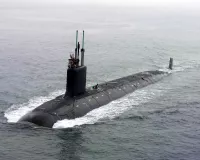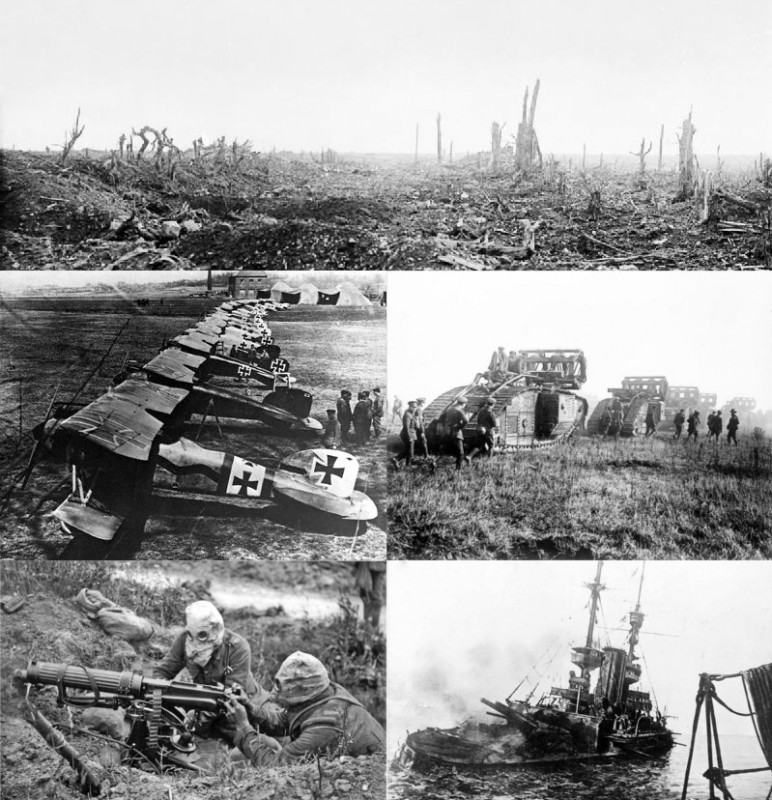World War I, a global conflict between the Allies and Central Powers, primarily in Europe and the Middle East, was marked by trench warfare, artillery, machine guns, chemical weapons, tanks, and aircraft. One of history's deadliest conflicts, it resulted in approximately 10 million military deaths, over 20 million wounded, and around 10 million civilian deaths, including those from genocide. The war's mass population movements also contributed to the spread of the deadly Spanish flu pandemic.
1906: Launch of HMS Dreadnought
In 1906, the launch of HMS Dreadnought gave the British a technological advantage in naval power.
1906: Schlieffen Plan Estimated Completion
The creator of the Schlieffen Plan, Alfred von Schlieffen, estimated that the plan would take six weeks to complete. He was the head of the German General Staff from 1891 to 1906.
1907: Anglo-Russian Convention
The Triple Entente was completed by the 1907 Anglo-Russian Convention.
1907: Violation of the 1907 Hague Convention
The use of chemical weapons in warfare during World War I was a direct violation of the 1907 Hague Convention on Land Warfare, which prohibited their use.
1908: Moltke changes force allocation
In 1908, Helmuth von Moltke the Younger, concerned about a potential French push on the left flank, modified the Schlieffen Plan's allocation of forces, changing it from 85:15 to 70:30 between the right and left wings as the German Army increased in size.
1908: Economic reforms in Russia
Post-1908 economic reforms in Russia led to expansion of railways and infrastructure, particularly in western border regions.
1908: Bosnian Crisis
The 1908 Bosnian Crisis began when Austria annexed Bosnia and Herzegovina, which it had occupied since 1878.
1909: Denouncement of Austrian annexation
In 1909, the Austrian annexation of Bosnia was denounced by European powers, but ultimately accepted.
1910: 1910 Census in Hungary
According to the 1910 census, speakers of the Hungarian language included approximately 54% of the entire population of the Kingdom of Hungary.
1911: Armaments Turning Point
In 1911, Chancellor Theobald von Bethmann Hollweg acknowledged defeat in the naval arms race, leading to the Rüstungswende, or 'armaments turning point', when he switched expenditure from the navy to the army.
1911: Russian Stavka agrees to attack Germany
In 1911, the Russian Stavka and the French agreed that Russia would attack Germany within fifteen days of mobilization, a commitment made ten days before the Germans had anticipated. This meant that the Russian armies entered East Prussia on August 17 without full support.
1911: Italo-Turkish War
Tensions increased after the 1911 Italo-Turkish War demonstrated Ottoman weakness.
November 1912: Austrian mobilization
In November 1912, the Serbian capture of ports on the Adriatic resulted in partial Austrian mobilization.
1912: Home Rule Crisis Resurfaced in Ireland
In 1912, the Home Rule crisis resurfaced in Ireland, contributing to the political tensions and unrest in the lead up to the war.
1913: First Balkan War
In 1913, The Balkan League overran most of the Ottomans' territory in the Balkans during the 1912–1913 First Balkan War.
July 1914: Civil war possibility in Ireland
By July 1914, there was a serious possibility of an outbreak of civil war in Ireland.
August 1914: The Great War
In August 1914, The Independent magazine referred to the conflict as "The Great War".
August 1914: Socialist Parties Support the War
In August 1914, at the start of World War I, several socialist parties initially supported the war. However, European socialists later split along national lines as patriotic support for the war superseded the concept of class conflict.
August 1914: New Zealand occupies German Samoa
On August 30, 1914, New Zealand forces successfully occupied German Samoa (now Samoa).
August 1914: The First Air Campaign
The book "The First Air Campaign: August 1914 – November 1918" covers the first air campaign
September 1914: "Race to the Sea" after the First Battle of the Marne
After the First Battle of the Marne in September 1914, Allied and German forces engaged in the "Race to the Sea", attempting to outflank each other. By the end of 1914, they faced each other along an uninterrupted line of entrenched positions from the Channel to the Swiss border.
September 1914: First World War
In September 1914, German biologist Ernst Haeckel used the term "First World War."
September 1914: Russia Acknowledges Romanian Rights
In September 1914, Russia acknowledged Romanian rights to Austro-Hungarian territories including Transylvania and Banat.
September 1914: Russian Defeats at Masurian Lakes
In September 1914, Russia suffered defeats at the Masurian Lakes, forcing them to withdraw from East Prussia with heavy losses.
October 1914: Mussolini Forms Pro-Interventionist Group
In October 1914, Benito Mussolini formed the pro-interventionist Il Popolo d'Italia and the Fasci Rivoluzionario d'Azione Internazionalista to encourage socialists and revolutionaries to support Italy's entry into the war.
October 1914: This is the Great War
In October 1914, Maclean's magazine referred to the conflict as "This is the Great War."
November 1914: SMS Emden sinks two British armored cruisers
In November 1914, the SMS Emden, part of the German East Asia Squadron, sank two British armoured cruisers at the Battle of Coronel before being virtually destroyed at the Battle of the Falkland Islands in December.
December 1914: Ottoman Offensive in the Caucasus
In December 1914, Enver Pasha launched an offensive against the Russians in the Caucasus with 100,000 troops, insisting on a frontal attack against mountainous Russian positions in winter, leading to heavy losses.
1914: Austrian attacks repulsed
Beginning on August 12, 1914, Austrian attacks were repulsed with heavy losses. As a result, Austria had to keep sizeable forces on the Serbian front, weakening their efforts against Russia. Serbia's victory against Austria-Hungary in the 1914 invasion has been called one of the major upset victories of the twentieth century.
1914: Resentment, nationalism and insecurity
By 1914, resentment, nationalism and insecurity helped explain why the pre-1914 Balkans became known as the "powder keg of Europe".
1914: Germany fails to achieve primary objective
By the end of 1914, German troops held strong defensive positions inside France, controlled most of France's coalfields, and inflicted more casualties than they suffered. However, communication problems and command decisions prevented a decisive victory, and Germany failed to avoid a long, two-front war. Crown Prince Wilhelm stated that Germany had lost the war.
1914: Wilson's conviction that Germany must be defeated
Despite his conviction that Germany must be defeated, Wilson went to war in 1914 to ensure the US played a leading role in shaping the peace, which meant preserving the AEF as a separate military force, rather than being absorbed into British or French units as his Allies wanted.
1914: European Military Mobilization
From 1914 to 1918, of the 60 million European military personnel who were mobilised, an estimated 8 million were killed, 7 million were permanently disabled, and 15 million were seriously injured.
1914: Typhus Epidemic in Serbia
In 1914 alone, louse-borne epidemic typhus killed 200,000 in Serbia.
1914: Serbian counter-attack drives Austrians from the country
In 1914, Austria-Hungary could only spare one-third of its army to attack Serbia. After suffering heavy losses, the Austrians briefly occupied Belgrade, but a Serbian counter-attack in the Battle of Kolubara drove them from the country by the end of the year.
1914: Germany attempts to use Indian nationalism and pan-Islamism
In 1914, Germany attempted to leverage Indian nationalism and pan-Islamism to its advantage, continuing this policy by instigating uprisings in India. Despite British fears, the outbreak of war saw a reduction in Indian nationalist activity.
1914: Moltke cancels incursion into the Netherlands
In 1914, Helmuth von Moltke, recognizing the importance of Dutch neutrality for German trade, decided to cancel the planned incursion into the Netherlands as part of the Schlieffen Plan. This change meant that any delays in Belgium would threaten the plan's viability.
1914: Cannons Positioned in the Front Line
In 1914, cannons were typically positioned in the front line and fired directly at their targets.
1914: Obsolete military tactics lead to trench warfare
In 1914, pre-war military tactics emphasizing open warfare became obsolete due to technological advancements. Strong defensive systems, including barbed wire, machine guns, and powerful artillery, dominated the battlefield, making infantry advances extremely difficult and leading to trench warfare.
1914: Indian soldiers and laborers serve in WWI
In 1914, the British Indian Army was larger than the British Army itself. Between 1914 and 1918, an estimated 1.3 million Indian soldiers and laborers served in Europe, Africa, and the Middle East, with 140,000 soldiers serving on the Western Front and nearly 700,000 in the Middle East.
1914: Italian Army Pre-War State
In 1914, the pre-war Italian army was short of officers, trained men, adequate transport and modern weapons.
1914: Crises in the Balkans
The years before 1914 were marked by a series of crises in the Balkans, as other powers sought to benefit from the Ottoman decline.
April 1915: Italian Army Unprepared for Offensive
By April 1915, the pre-1914 Italian army which was short of officers, trained men, adequate transport and modern weapons, had remedied some of these deficiencies, but it was still unprepared for the major offensive required by the Treaty of London.
April 1915: Germans use chlorine gas at the Second Battle of Ypres
On April 22, 1915, at the Second Battle of Ypres, the Germans violated the Hague Convention by using chlorine gas on the Western Front for the first time.
May 1915: Second Battle of Ypres
During the Second Battle of Ypres in May 1915, the German army successfully deployed chemical weapons, after German scientists at the Kaiser Wilhelm Institute developed a method to weaponise chlorine. The use of chemical weapons had been sanctioned by the German High Command to force Allied soldiers out of their entrenched positions, complementing rather than supplanting more lethal conventional weapons.
May 1915: Gorlice-Tarnów Offensive
In May 1915, the Gorlice–Tarnów offensive allowed the Central Powers to invade Russian-occupied Poland.
October 1915: Bulgaria declares war on Serbia
On October 14, 1915, Bulgaria declared war on Serbia and joined the attack by the Austro-Hungarian army. The Central Powers conquered Serbia in a little over a month, sending in 600,000 troops. The Serbian army retreated into northern Albania, suffering defeat in the Battle of Kosovo.
1915: Encephalitis Lethargica Epidemic
Between 1915 and 1926, an epidemic of encephalitis lethargica affected nearly 5 million people worldwide.
1915: Sinking of the RMS Lusitania
In 1915, after the sinking of the passenger ship RMS Lusitania, Germany promised not to target passenger liners, leading Britain to arm its merchant ships, placing them outside of 'cruiser rules'.
1915: Attacks on Ethnic Groups
In 1915, other ethnic groups including Assyrians and Greeks were similarly attacked by the Ottoman Empire.
1915: First use of anti-aircraft warfare
In 1915, the campaign saw the first use of anti-aircraft warfare after an Austrian plane was shot down with ground-to-air fire, as well as the first medical evacuation by the Serbian army.
1915: Terms of the Triple Alliance treaty made public
In 1915, the terms of the treaty that joined Italy to the Triple Alliance in 1882, was so controversial that subsequent governments denied its existence and the terms were only made public in 1915.
1915: Tehcir Law (Law on Deportation)
In early 1915, the Ottoman government issued the Tehcir Law (Law on Deportation), which authorized the deportation of Armenians from the Empire's eastern provinces to Syria between 1915 and 1918. The Armenians were intentionally marched to death and a number were attacked by Ottoman brigands. The ethnic cleansing of the Ottoman Empire's Armenian population, including mass deportations and executions, during the final years of the Ottoman Empire is considered genocide.
1915: Franco-British force lands at Salonica
In late 1915, a Franco-British force landed at Salonica in Greece to offer assistance and pressure the government to declare war against the Central Powers. However, King Constantine I dismissed the pro-Allied government of Eleftherios Venizelos before the Allied expeditionary force arrived.
1915: Majority of Irish Consented to Participate
While a minority of Irish nationalists opposed taking part, the vast majority of Irish people consented to participate in the war in 1914 and 1915.
January 1916: Montenegro covers Serbian retreat
On January 6–7, 1916, Montenegro covered the Serbian retreat toward the Adriatic coast in the Battle of Mojkovac, but ultimately the Austrians also conquered Montenegro. The surviving Serbian soldiers were evacuated to Greece and Serbia was divided between Austro-Hungary and Bulgaria after the conquest.
February 1916: Germans attack Verdun
In February 1916, the Germans launched an attack on French defensive positions at Verdun, initiating a battle that would last until December 1916. Casualties were heavy on both sides, with 700,000 to 975,000 casualties. Verdun became a symbol of French determination and self-sacrifice.
June 1916: Start of the Arab Revolt
In June 1916, the Arab Revolt started with the Battle of Mecca, led by Sharif Hussein, who declared the independence of the Kingdom of Hejaz.
June 1916: Brusilov Offensive
In June 1916, the Brusilov Offensive against the Austrians in eastern Galicia was successful, diverting German resources from Verdun, relieving Austro-Hungarian pressure on the Italians, and convincing Romania to enter the war on the side of the Allies.
June 1916: Battle of Jutland ends
The Battle of Jutland, the only full-scale clash of battleships during the war, ended in June 1916. Although the clash was indecisive, the Germans inflicted more damage than they received. Subsequently, the German High Seas Fleet was confined to port.
July 1916: Battle of the Somme begins
The Battle of the Somme, an Anglo-French offensive, began in July 1916. The first day, July 1, 1916, was the British Army's bloodiest day, with 57,500 casualties, including 19,200 dead.
August 1916: Capture of Gorizia
In August 1916, Gorizia was captured by Italian forces but the Isonzo front remained static until October 1917.
August 1916: German and Ottoman force defeated at Romani
In August 1916, a German and Ottoman force was defeated at the Battle of Romani by the ANZAC Mounted Division and the 52nd (Lowland) Infantry Division. This event marked a turning point in the defense of the Suez Canal.
November 1916: French and Serbian forces retake Bitola
On November 19, 1916, French and Serbian forces retook limited areas of Macedonia by recapturing Bitola, following the costly Monastir offensive, which brought stabilisation of the front.
November 1916: Battle of the Somme ends
The Anglo-French offensive, Battle of the Somme ended in November 1916. The Somme offensive led to an estimated 420,000 British casualties, along with 200,000 French and 500,000 German. Diseases in the trenches such as trench foot, lice, typhus, trench fever, and the 'Spanish flu', led to many deaths on both sides.
December 1916: Robert Nivelle Replaces Pétain
In December 1916, Robert Nivelle replaced Pétain as commander of French armies on the Western Front and began planning a spring attack in Champagne, part of a joint Franco-British operation.
December 1916: Germans attack Verdun ends
In February 1916, the Germans launched an attack on French defensive positions at Verdun, initiating a battle that lasted until December 1916. Casualties were heavy on both sides, with 700,000 to 975,000 casualties. Verdun became a symbol of French determination and self-sacrifice.
December 1916: Germany Attempts to Negotiate Peace
On 12 December 1916, after ten brutal months of the Battle of Verdun and a successful offensive against Romania, Germany attempted to negotiate a peace with the Allies; however, this attempt was rejected as a "duplicitous war ruse".
December 1916: Bucharest Surrenders to Central Powers
On 6 December 1916, a combined German-Bulgarian-Turkish offensive captured Dobruja and Giurgiu, and Bucharest surrendered to the Central Powers.
1916: Russian Casualties and Shortages
By the end of 1916, Russian casualties totalled nearly five million killed, wounded or captured, with major urban areas affected by food shortages and high prices.
1916: Arab Revolt Begins
In 1916, the Arab Revolt commenced in Ottoman-controlled territories of the Middle East, driven by Arab nationalists seeking independence and the creation of a pan-Arab state.
1916: Growing Unrest in Russia
In 1916, unrest grew in Russia, Tsar Nicholas II remained at the front and the home front was controlled by Empress Alexandra leading to food shortages in urban areas led to widespread protests and the murder of her favourite, Grigori Rasputin, at the end of 1916.
1916: US Loans to Allies Increased
In late 1916, President Wilson initially considered halting loans to the Allies but ultimately allowed a substantial increase in lending by the US government.
January 1917: Battle of Rafa
In January 1917, the Egyptian Expeditionary Force continued its advance across the Sinai Peninsula, pushing Ottoman forces back in the Battle of Rafa on the border between the Egyptian Sinai and Ottoman Palestine.
March 1917: British capture Baghdad
In March 1917, British Imperial forces, aided by local Arab and Assyrian fighters, reorganized and captured Baghdad in Mesopotamia after the defeat of the British defenders in the siege of Kut by the Ottomans (1915–1916).
March 1917: Tsar Nicholas orders suppression of strikes
In March 1917, Tsar Nicholas ordered the military to forcibly suppress strikes in Petrograd but the troops refused to fire on the crowds. Revolutionaries set up the Petrograd Soviet and Nicholas abdicated.
April 1917: First and Second Battles of Gaza
In April 1917, at the First and Second Battles of Gaza, German and Ottoman forces stopped the advance of the Egyptian Expeditionary Force.
April 1917: United States joins the Allies
In April 1917, the United States joined the Allies after Germany resumed unrestricted submarine warfare against Atlantic shipping.
April 1917: Lenin Returns to Russia
On 16 April 1917, Vladimir Lenin was ushered from Switzerland into Russia with the help of the German government.
April 1917: United States Declares War on Germany
On April 6, 1917, the United States Congress declared war on Germany. The US Navy deployed a battleship group to join the Grand Fleet, and provided convoy escorts. The US Army had fewer than 300,000 men, including National Guard units.
May 1917: Workers and Soldiers Demonstrate in Petrograd
From 1–4 May 1917, approximately 100,000 workers and soldiers in Petrograd, led by the Bolsheviks, demonstrated under banners calling for an end to the war and for power to the Soviets, creating a crisis for the Russian Provisional Government.
May 1917: Bolshevik Rioting in Milan
In May 1917, Bolshevik revolutionaries in Milan organized riots calling for an end to the war. The Italian army intervened with tanks and machine guns, resulting in almost 50 deaths and over 800 arrests.
October 1917: Major Victory at Caporetto
In October 1917, a combined Austro-German force won a major victory at Caporetto, leading to Cadorna being replaced by Armando Diaz, who retreated to positions along the Piave River.
December 1917: Central Powers sign armistice with Russia
In December 1917, the Central Powers signed an armistice with Russia, freeing large numbers of German troops for use in the West.
1917: Luigi Cadorna's Frontal Assaults
Between 1915 and 1917, the Italian commander, Luigi Cadorna, undertook a series of frontal assaults along the Isonzo, which made little progress and cost many lives.
1917: Indirect Fire Commonplace
By 1917, indirect fire with guns, mortars, and even machine guns was commonplace, using new techniques for spotting and ranging, notably, aircraft and the field telephone.
1917: Modernization of Major Armies
By the end of 1917, major armies had modernized, utilizing technologies such as telephone, wireless communication, armored cars, tanks (including the prototype tank Little Willie), and aircraft.
1917: Montagu allegedly promises Indian Home Rule
In 1917, Edwin Montagu, the Secretary of State for India, allegedly made an explicit promise of Indian Home Rule, leading Indian National Congress leaders to believe that supporting the British war effort would hasten the achievement of self-governance.
1917: Allies suffer heavy losses
In 1917, the Allies suffered heavy losses, which frustrated Wilson. He insisted on retaining control of American troops, and refused to commit them to the front line until able to operate as independent units.
1917: Russian withdrawal from the war
In 1917, the Russian withdrawal from the war led Armenian and Assyrian forces to be cut off from supply lines, outnumbered, and isolated, forcing them to fight and flee towards British lines in northern Mesopotamia.
1917: Introduction of convoys escorted by destroyers
In 1917, the U-boat threat lessened when merchant ships began traveling in convoys escorted by destroyers. This tactic made it difficult for U-boats to find targets and enabled destroyers to attack submerged submarines with hydrophones and depth charges. Convoys slowed down supplies so a program of building new freighters was established.
1917: Espionage Act Passed in US
In 1917, the US passed the Espionage Act, making it a federal crime to oppose military recruitment or make "disloyal" statements.
1917: US conscription begins
In 1917, the United States initiated conscription to bolster its military forces. This move was generally well-received, with only minor opposition in rural areas. The shift to conscription occurred after voluntary enlistment fell short of the initial target of one million, with only 73,000 enlisting during the first six weeks.
1917: Germany adopts unrestricted submarine warfare
In early 1917, Germany adopted a policy of unrestricted submarine warfare, aiming to strangle Allied sea lanes before the United States could transport a large army overseas. This decision was made with the realization that the Americans would eventually enter the war.
1917: Central Powers Offensive in Romania
In the summer of 1917, a Central Powers offensive began in Romania under the command of August von Mackensen to knock Romania out of the war, resulting in the battles of Oituz, Mărăști and Mărășești.
March 1918: Soviet Russia signs separate peace
In March 1918, Soviet Russia signed a separate peace with the Central Powers, following an armistice in December 1917 after the Bolsheviks seized power.
March 1918: Treaty of Brest-Litovsk
In March 1918, the Bolsheviks acceded to the Treaty of Brest-Litovsk, ceding vast territories to the Central Powers after German troops began marching across Ukraine unopposed.
March 1918: Operation Michael Commences
On 21 March 1918, Operation Michael, part of the 1918 offensive on the Western Front, commenced with an attack on British forces near Saint-Quentin. German forces achieved an unprecedented advance of 60 kilometres (37 mi), but the offensive was eventually halted.
April 1918: Romania takes control of Bessarabia
In April 1918, Romania took control of Bessarabia as the Russian Empire lost much of its western frontier.
April 1918: Rome Congress of Oppressed Nationalities
In April 1918, the Rome Congress of Oppressed Nationalities met, including Czechoslovak, Italian, Polish, Transylvanian, and Yugoslav representatives. They urged the Allies to support national self-determination for the peoples within Austria-Hungary.
May 1918: Romania signs the Treaty of Bucharest
In May 1918, Romania, isolated on the Eastern Front after Russia's exit from the war, signed the Treaty of Bucharest with the Central Powers, ceding territory to Austria-Hungary and Bulgaria and leasing its oil reserves to Germany. The treaty also included the Central Powers' recognition of Bessarabia's union with Romania.
June 1918: American Expeditionary Forces in France
By June 1918, over 667,000 members of the American Expeditionary Forces (AEF) were transported to France. This figure reached 2 million by the end of November.
June 1918: Second Austrian Offensive Repulsed
In June 1918, a second Austrian offensive was repulsed by Italian forces.
July 1918: First use of aircraft carriers in combat
In July 1918, World War I saw the first use of aircraft carriers in combat. HMS Furious launched Sopwith Camels in a successful raid against the Zeppelin hangars at Tondern, and blimps were used for antisubmarine patrol.
August 1918: Allied Hundred Days Offensive begins
Beginning in August 1918, the Allied Hundred Days Offensive caused a collapse of the German front line.
September 1918: Breakthrough in the Vardar offensive
In September 1918, Serbian and French troops made a breakthrough in the Vardar offensive, after most German and Austro-Hungarian troops had been withdrawn. The Bulgarians were defeated at the Battle of Dobro Pole. By September 25, 1918, British and French troops had crossed the border into Bulgaria as the Bulgarian army collapsed.
September 1918: Meuse-Argonne Offensive
In late September 1918, the first significant US involvement in the war was the Meuse-Argonne offensive, after Wilson ensured the US played a leading role in shaping the peace. Wilson preserved the AEF as a separate military force, and insisted on retaining control of American troops.
September 1918: Bulgaria Signs Armistice
On 29 September 1918, Bulgaria was the first to sign an armistice, the Armistice of Salonica. On the same day, the German Supreme Army Command informed Wilhelm II and the Imperial Chancellor Count Georg von Hertling, that the military situation facing Germany was hopeless.
October 1918: German Revolution Begins
At the end of October 1918, the German Revolution of 1918–1919 began. Units of the German Navy refused to set sail for a large-scale operation.
November 1918: Romania Re-enters the War
In November 1918, Romania re-entered the war on the side of the Allies, and the Treaty of Bucharest was formally annulled by the Armistice of 11 November 1918.
November 1918: Armistice of 11 November 1918
Most commemorations of the war's end concentrate on the armistice of 11 November 1918.
November 1918: Proclamation of the Republic in Germany
On 9 November 1918, the sailors' revolt in the naval ports of Wilhelmshaven and Kiel spread across the whole country and led to the proclamation of a republic, the abdication of Wilhelm II, and German surrender.
November 1918: The First Air Campaign
The book "The First Air Campaign: August 1914 – November 1918" covers the first air campaign
November 1918: End of World War I
World War I ended on November 11, 1918, after resulting in an estimated 10 million military deaths and 20 million wounded, plus 10 million civilian deaths. The movement of large numbers of people was a major factor in the deadly Spanish flu pandemic.
1918: Centenary of the 1918 Armistice
As part of commemorations for the centenary of the 1918 Armistice, French President Emmanuel Macron and German Chancellor Angela Merkel visited the site of the signing of the Armistice of Compiègne and unveiled a plaque to reconciliation.
1918: Deportation of Armenians
Between 1915 and 1918, the Armenians were intentionally marched to death and a number were attacked by Ottoman brigands. The ethnic cleansing of the Ottoman Empire's Armenian population, including mass deportations and executions, during the final years of the Ottoman Empire is considered genocide.
1918: The War to End War
By 1918, the conflict was being described as "the war to end war" due to its unprecedented scale and devastation.
1918: End of WWI leads to disillusionment in India
By 1918, the end of the war, the suffering and the British government's failure to grant self-government to India led to disillusionment, spurring a campaign for full independence led by Mahatma Gandhi.
1918: Civilian Deaths in Germany
In 1918, civilian deaths in Germany were 271,000 higher than in peacetime, due in large part to food shortages and malnutrition that had weakened disease resistance.
1918: Conscription Crisis of 1918 in Ireland
In 1918, opposition to involvement in the war increased in Ireland, resulting in the Conscription Crisis.
1918: End of Persian Campaign
In 1918, the Persian campaign ended in failure for the Ottomans and their allies, although Russian withdrawal impacted allied forces.
1918: Sedition Act Passed in US
In 1918, the US passed the Sedition Act, further restricting freedom of speech during the war. Publications critical of the government were censored, and many individuals faced imprisonment for making statements deemed unpatriotic.
1918: Spanish Flu Epidemic
Starting in early 1918, a major influenza epidemic known as Spanish flu spread across the world, accelerated by the movement of large numbers of soldiers. The Spanish flu killed at least 17 to 25 million people.
1918: Aircraft Carriers Used for First Time
Towards the end of the conflict in 1918, aircraft carriers were used for the first time. HMS Furious launched Sopwith Camels in a raid to destroy the Zeppelin hangars at Tønder.
January 1919: Surrender of Medina
In January 1919, Fakhri Pasha, the Ottoman commander of Medina, surrendered after resisting for more than 2 1/2 years during the siege of Medina.
June 1919: League of Nations Established
On 28 June 1919, the League of Nations was established, building on Wilson's 14th point of the Treaty of Versailles. The Paris Peace Conference imposed a series of peace treaties on the Central Powers officially ending the war. The 1919 Treaty of Versailles dealt with Germany.
June 1919: Signing of the Treaty of Versailles
On 28 June 1919, the Treaty of Versailles with Germany was signed, marking a formal end to the state of war between the two sides.
1919: US Demands Repayment of Loans
After 1919, the United States began demanding repayment of the loans it had extended to Britain and other Allies during World War I. These repayments were partially funded by German reparations, which were, in turn, supported by American loans to Germany.
1919: Fasci Italiani di Combattimento Formed
In 1919, Mussolini's Fasci Rivoluzionario d'Azione Internazionalista later developed into the Fasci Italiani di Combattimento, which marked the origin of fascism.
1919: Civilian Deaths in Germany
In the first half of 1919, civilian deaths in Germany were 71,000 higher than in peacetime, due in large part to food shortages and malnutrition that had weakened disease resistance.
1919: Versailles Treaty Signed in 1919
Some war memorials date the end of the war as being when the Versailles Treaty was signed in 1919, which was when many of the troops serving abroad finally returned home.
1919: German Revolution of 1918-1919
The German Revolution of 1918-1919 continued into 1919, following the abdication of Wilhelm II and German surrender.
1919: Paris Peace Conference
The Paris Peace Conference began in 1919, imposing settlements on the defeated powers.
1920: Hungarian Territories Attached to Romania, Czechoslovakia, and Yugoslavia
Between 1920 and 1924, 354,000 Hungarians fled former Hungarian territories attached to Romania, Czechoslovakia, and Yugoslavia, as a result of Austria-Hungary being partitioned.
July 1921: Knox-Porter Resolution
On 2 July 1921, President Warren G. Harding signed the Knox–Porter Resolution, formally ending the US involvement in the war.
1921: Total Reparation Sum Placed at 132 Billion Gold Marks
In 1921, the total reparation sum to be paid by Germany was set at 132 billion gold marks. However, it was understood by Allied experts that Germany would be unable to pay this amount. The actual assessment of German capacity to pay was 50 billion gold marks.
1922: Attacks on Ethnic Groups
Between 1915 and 1922, at least 250,000 Assyrian Christians and 350,000–750,000 Anatolian and Pontic Greeks were killed by the Ottoman Empire.
1924: Hungarian Territories Attached to Romania, Czechoslovakia, and Yugoslavia
Between 1920 and 1924, 354,000 Hungarians fled former Hungarian territories attached to Romania, Czechoslovakia, and Yugoslavia, as a result of Austria-Hungary being partitioned.
1926: Encephalitis Lethargica Epidemic
Between 1915 and 1926, an epidemic of encephalitis lethargica affected nearly 5 million people worldwide.
1929: Great Depression Caused Political Chaos
In 1929, the Great Depression led to widespread political chaos.
1931: Collapse of Circular Loan System
In 1931, the circular system of loan repayments, involving the US, Britain, and Germany, collapsed, leading to some loans never being repaid.
1932: Payment of Reparations Suspended
In 1932, the international community suspended Germany's reparation payments. By this point, Germany had paid only the equivalent of 20.598 billion gold marks.
1934: Britain Still Owes US
In 1934, Britain still owed the United States $4.4 billion in World War I debt.
1939: Outbreak of World War II
In 1939, the failure of the League of Nations to maintain stability during the interwar period contributed to the outbreak of World War II.
2002: 11 Funds Still Functioning in New Zealand
As of 2002, 11 of the New Zealand patriotic funds from WWI were still functioning, despite reforms at the start of the next world war following criticisms of overlapping, wastefulness and abuse.
2002: The First Air Campaign
In 2002, Eric and Jane Lawson published the book "The First Air Campaign: August 1914 – November 1918."
October 2010: Germany's Final Payment
On 3 October 2010, Germany made its final payment on the bonds issued during the 1920s and early 1930s.
August 2014: Centenary of Germany's Declaration of War on France Marked
On 3 August 2014, French President François Hollande and German President Joachim Gauck marked the centenary of Germany's declaration of war on France by laying the first stone of a memorial in Vieil Armand for French and German soldiers killed in the war.
2015: Britain's Final WWI Debt Payment
In 2015, Britain made its final installment payment on its World War I debt to the United States.
2018: British Government Commemorates the War
The British government budgeted substantial resources to the commemoration of World War I during the period 2014 to 2018, with the Imperial War Museum as the lead body.
Mentioned in this timeline
Ukraine is a large country in Eastern Europe second in...
The United States of America is a federal republic located...

A submarine is a watercraft capable of independent operation underwater...
New Zealand is an island country located in the southwestern...
India officially the Republic of India is a South Asian...
Germany officially the Federal Republic of Germany is a Western...
Trending

Jermaine Demetrius Burton is an American professional football wide receiver and return specialist currently playing for the Cincinnati Bengals of...

7 months ago Paolo Banchero's NBA Journey: Overcoming Injury, Praising Teammates, and Hope for the Future

6 months ago Julia Fox Ditches Beauty Trend, Net Worth Soars: An 'It Girl' in 2025

1 month ago Jayden Reed Injury Update: Packers WR Setback and Recovery Timeline

14 days ago Scott Bessent Predicts Oil Price Drop Contingent on Venezuelan Events; Gas Prices Impacted.
4 days ago David Corenswet Visits Alma Mater; Brainiac Shortlist Includes Bang, Smith, and Rockwell
Popular
Matt and Ross Duffer known as the Duffer Brothers are...
Aftyn Alyssa Behn is an American politician currently serving as...

Candace Owens is an American conservative political commentator and author...

XXXTentacion born Jahseh Dwayne Ricardo Onfroy was a controversial yet...

Ilhan Omar is an American politician currently serving as the...

Lane Kiffin is an American football coach currently serving as...

